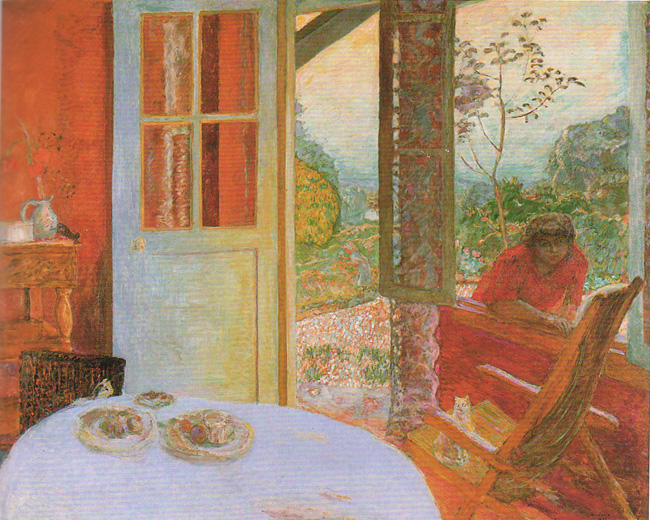When you look at paintings, you’ll notice that most of them have a noticeable point of focus — the area of the canvas that your eye gets drawn toward. Music is not much different; in most songs, you’ll notice that there’s a point of focus. The only difference is that in songs, you usually have to wait to hear that point, while paintings offer it to you right away.
And in fact, both music and art will offer several points for the audience to focus on: a main one, but other subordinate spots that offer their own level of interest.

Pierre Bonnard, Dining Room in the Country
I’m not an artist, and so I won’t try to tell you much about Bonnard’s techniques or motivations. I can tell you that the painting above is of his dining room table in Verronet, France. That’s his wife looking in at the scene. He apparently painted the scene from memory.
 Looking for lists of progressions you can use in your own songs? “The Essential Secrets of Songwriting” eBook Bundle has 2 main collections, plus eBooks on how to harmonize your own melodies, and more.
Looking for lists of progressions you can use in your own songs? “The Essential Secrets of Songwriting” eBook Bundle has 2 main collections, plus eBooks on how to harmonize your own melodies, and more.
But on the topic of point of focus, I think you’ll agree that as you look from one side of the canvas to the other, you’ll find your eye drawn to several different objects. The table is obviously noticeable and imposing. The cat in the chair is interested in the food on the table. The garden is beautiful, and I find that the land behind has a way of pulling my attention away from the scene at the house. Orange seems to be the overpowering colour, but I find that that makes me look for the non-orange things.
And you can have an interesting discussion with someone about what (or who) Bonnard intended to be the point of focus. Maybe the lesson here is that life doesn’t always give us one main point of focus: perhaps our brains fuse all points together.
In music, we often talk about a point of focus, and we’re often talking about melodies when we do. The point of focus is often the highest point, and I have written many times about the climactic high point we find in most good song melodies.
Without some focal point, we find that our brains automatically search for one. Or it gives up.
In pop music, a musical journey lasts 3 to 4 minutes. And in that journey, we typically need to hear something that jumps out at us, something that says, “this is what this song is all about.”
Do your songs have an important point of focus? It doesn’t need to be in the melody, though that’s an important one. And like a good painting, a good song will often have several points where we say, “Ahhh… that’s what I’ve been waiting to hear!”
In addition to melodies with high points, you’ll want to think about:
- Lyrics with a good pay-off line. A pay-off line is one where the point or purpose of the lyric is displayed front and centre. Good pay-off lines are often clever or imaginative, will happen either at the beginning or end of a chorus, and will often be the song’s title. (“I Walk the Line” – Johnny Cash)
- Chord progressions with an interesting moment or diversion. Most verses and choruses will use the same progression for each section, so the only truly unique progression might be in the optional bridge section. Bridges allow you to take your song in a new, interesting direction, and it’s a great spot for something powerful to happen. Be sure that you’re allowing your bridge to explore a new (even if related) key area. That will give your chords that all-important point of focus.
- Finding a moment for an interesting instrumental treatment. That moment might be a section where all instruments stop except for one (like the bass solo in Paul Simon’s “You Can Call Me Al”)
In a song with several interesting moments, one will usually stand out as being most significant, but as the songwriter, it’s not so crucial for you to decide which moment is most important. All that really matters is that you’ve given your listeners something to focus on and remember.
 Written by Gary Ewer. Follow Gary on Twitter.
Written by Gary Ewer. Follow Gary on Twitter.
 Even if you don’t have a background in music theory, there’s a lot about chord theory you can discover and use! Several eBooks in “The Essential Secrets of Songwriting” 10-eBook bundle (plus the free “Use Your Words!”) show you exactly why chords work the way they do, and then show you how to use them in your own songs.
Even if you don’t have a background in music theory, there’s a lot about chord theory you can discover and use! Several eBooks in “The Essential Secrets of Songwriting” 10-eBook bundle (plus the free “Use Your Words!”) show you exactly why chords work the way they do, and then show you how to use them in your own songs.











i would like to get to learn how to write a song and add the instruments that the song wants